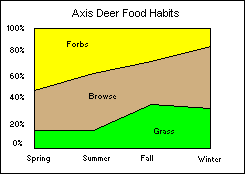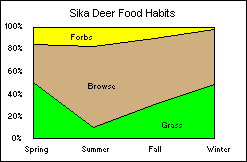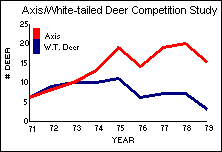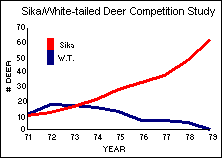White-tailed Deer
White-tailed Deer vs. Exotics
Exotic deer were brought into the Texas Hill County in the 1930s. Exotic numbers began to increase rapidly in the 1950's, with the birth of the hunting industry. Exotic surveys by Texas Parks and Wildlife Department began in the 1960's. At that time, there were 13 species and about 13,000 animals. The last survey was in 1996. At that time, there were 190,000 animals and 76 species. According to the Texas Exotic Association there are now over 250,000 exotics.
The Kerr Wildlife Management Area has conducted food habit studies on axis, sika, fallow, blackbuck antelope, and aoudad.


All these studies indicated most exotics were sheep or goats in a deer's clothing. That is, they either preferred forbs or preferred browse, but could do well on grass too. White-tailed deer prefer forbs when they are available. As forbs become unavailable, they shift their diet to browse. White-tailed deer cannot live on grass; in fact, they will die with a belly full of grass.
Texas Parks and Wildlife Department also conducted competition studies between white-tailed deer and exotics. Six 96-acre pastures, enclosed with "deer-proof" fence and not grazed by any other animals, were used to determine the effects of exotic ungulates (axis deer, sika deer, fallow deer, blackbuck antelope, and aoudad sheep) on white-tailed deer. Each pasture was stocked with 6 white-tailed deer, and 6 animals of one exotic species. For example, Pasture 1 contained 6 whitetails and 6 axis deer; Pasture 2 contained 6 whitetails and 6 sika; etc.


These studies indicated that exotic ungulates out-compete white-tailed deer, and white-tailed deer will die while exotics continue to thrive. Remember, white-tailed deer can live on only 2 classes of forage (forbs and browse), while exotics can do well on 3 classes (forbs, browse, and grass). As forbs and browse are removed from the area (from excessive grazing/browsing pressure), exotics can shift their diet to grass and white-tailed deer die from malnutrition.